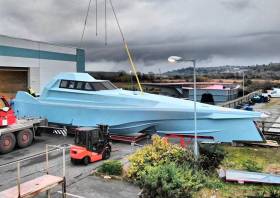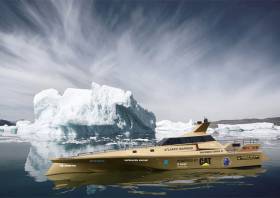Displaying items by tag: Thunder Child 2
Thunder Child II Taking Shape At Safehaven Marine
Thunder Child II is finally taking shape at Cork-based performance boatbuilders Safehaven Marine, with “another couple of more months” go before launch for sea trials in the New Year.
As previously noted on Afoat.ie, the XSV20 design developed over the past year crosses a wave-piercing monohull with a catamaran and is optimised for cutting through 4,000km of Atlantic sea with the aim of setting a new powerboat world record.
Safehaven Marine — with its design HQ in Cork Harbour and boatbuilding yard in Youghal — is also busy with its pilot boat commissions, the latest coming from Puerto Rico.
So finally after a year in development 'Thunder Child II' takes her shape. She looks pretty cool. Just another couple of more months work till her launch. pic.twitter.com/vXGnqKioKj
— Safehaven Marine (@SafehavenMarine) November 23, 2018
Safehaven Announces ‘Thunder Child 2’ Atlantic Record Attempt
#WorldRecord - Safehaven Marine has announced a new powerboat world record attempt — this time across the Atlantic.
Frank Kowalski, managing director of the Cork Harbour boatyard, has developed what the Irish Examiner is calling a “radical” new hull for Thunder Child 2.
Crossing a wave-piercing monohull with a catamaran hull, the new design promises to cut through more than 4,000km of Atlantic seas in under four days.
In May, Safehaven previewed the design of what’s officially the XSV20, which has completed scale model tests ahead of construction of the first demonstrator model due for launch in the new year.
Kowalski says the XSV20 was developed “in one’s endless pursuit of travelling fast in rough seas”.
And he will be putting that statement to the test next summer, between July and September, across the ‘northern route’ from Newfoundland to Killybegs via Greenland and Iceland for refuelling.

The Safehaven MD and his crew set a new round Ireland record in summer 2017 with the original Thunder Child, a Barracuda XSV 17 interceptor that can reach speeds of 60 knots.
Thunder Child 2 will come with its predecessor’s military-grade navigation technology and shock-dampening seats, and will be powered by four Caterpillar C8.7 650hp engines providing top speeds in excess of 50 knots.
Aside from the company’s record-breaking plans, Safehaven recently launched its third pilot vessel for Malta Maritime Pilots in Valletta.
The Interceptor 48, Juliet, is also the 35th Safehaven pilot boat to enter ports service internationally.
Number 36 is due next month when Safehaven delivers another Interceptor 48 for the Port of Leixões in Portugal under a contract with marine services firm Svitzer.
























